 GrassrootsHealth has been running the world’s largest population field trial on vitamin D since 2007, and was created to provide a set of tools for solving the vitamin D deficiency epidemic. Through the launch of the D*action project, GrassrootsHealth began to spread the word about vitamin D and its many benefits to our health, and to get information about the research from the scientists out to the public — all while providing an easily accessible way for anyone to measure their vitamin D level (which was hard to do at the time!) and learn what actions to take for themselves on an individual level.
GrassrootsHealth has been running the world’s largest population field trial on vitamin D since 2007, and was created to provide a set of tools for solving the vitamin D deficiency epidemic. Through the launch of the D*action project, GrassrootsHealth began to spread the word about vitamin D and its many benefits to our health, and to get information about the research from the scientists out to the public — all while providing an easily accessible way for anyone to measure their vitamin D level (which was hard to do at the time!) and learn what actions to take for themselves on an individual level.
The realization of the influence that other nutrients have on both vitamin D levels as well as overall health outcomes has led to the addition of several other tests to be included with the vitamin D test. Below is a summary of what is now available to all participants as additional measurements with their vitamin D level.
Including these tests along with the rest of your data can help everyone answer even more questions about these other nutrients and measurements, how they relate to each other, and to our overall health – build your Custom Test Kit today!
Participate with Your Custom Test Kit
Why Measure Vitamin D?
The most accurate determination of vitamin D status is the measurement of 25-hydroxyvitamin D, or 25(OH)D, in the blood. A Scientists’ Call to Action has been issued by 48 international vitamin D researchers to alert the public to the importance of having vitamin D serum levels between 40 and 60 nanograms/milliliter (ng/ml) (100-150 nanomoles/liter, nmol/L) to prevent disease. Almost 90% of U.S. adults have vitamin D levels below that range! Use the vitamin D*calculator to estimate an appropriate amount of vitamin D supplementation to get from a current vitamin D level to a target level.
Vitamin D supplements taken in the same amount can produce hugely different blood levels in different individuals due to a number of dietary, lifestyle, and individual factors. The presence or absence of vitamin D cofactors (such as magnesium or vitamin K), malabsorption issues (such as a food intolerance), the time of day, whether you take your supplement with food, and whether you smoke or take prescription or over-the-counter medications will all influence blood levels in response to supplementation. It is important to remember that it is the blood level that has been related to specific health outcomes, not simply the intake amount.
The desirable blood range is 40-60 ng/mL (100-150 nmol/L). Testing, and re-testing 3-6 months after making your adjustments, is the only way to find out if you are in the target range for vitamin D.
Learn more about the importance of measuring your vitamin D level and research involving vitamin D.
Learn More About Vitamin D for Health
Additional Finger-prick Blood Spot Tests Available as Options to Include with Your Vitamin D Test
Omega-3 Index Test
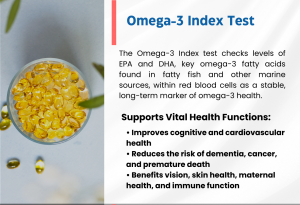 EPA (eicosapentaenoic acid) and DHA (docosahexaenoic acid) are two very important omega-3 fatty acids found in fatty fish and other marine sources, which are essential to our health. The Omega-3 Index is a measure of the amount of EPA and DHA in red blood cell membranes. The result is expressed as a percent of total RBC fatty acids, and is a long-term and stable marker of omega-3 status throughout the blood and tissues.
EPA (eicosapentaenoic acid) and DHA (docosahexaenoic acid) are two very important omega-3 fatty acids found in fatty fish and other marine sources, which are essential to our health. The Omega-3 Index is a measure of the amount of EPA and DHA in red blood cell membranes. The result is expressed as a percent of total RBC fatty acids, and is a long-term and stable marker of omega-3 status throughout the blood and tissues.
A higher Omega-3 Index has been associated with improved cognitive function and cardiovascular health, lower risk of dementia, lower risk of cancer, longer life, and a reduced relative risk for death from any cause, including COVID-19. Omega-3s are beneficial for normal vision, anti-aging, skin health, maternal health, immune function, brain health, heart health, normal liver function, joints and muscles, and more.
Experts recommend an Omega-3 Index of at least 8%; while individual levels of omega-3s vary across the globe, most countries and regions have levels that are considered low to very low. An analysis of the GrassrootsHealth cohort showed that 82% of participants had an Omega-3 Index below 8%, however, among those who completed two or more tests, 71% of those with an Omega-3 Index less than 8% increased their index after their first test. Take advantage of this opportunity to improve your Omega-3 Index! Once you have your Omega-3 Index result, use the Omega-3 Index Calculator to determine an approximate additional DHA and EPA intake to help achieve your target index.
Learn more about the importance of measuring your Omega-3 Index and research involving the Omega-3 Index.
Learn More About the Omega-3 Index
AA:EPA with Omega-6:Omega-3 Ratio Test
(available only as an add-on to the Omega-3 Index test)
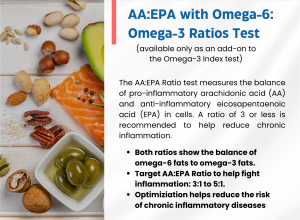 The AA:EPA Ratio test measures the ratio of the amount of the omega-6 fatty acid arachidonic acid (AA) and the omega-3 fatty acid eicosapentaenoic acid (EPA) in the cells. This test is a measurement of the amount of bad fats to good fats in the cells, and it can be an indication of the amount of cellular inflammation in the body, since AA is pro-inflammatory and EPA is anti-inflammatory. Experts recommend an AA:EPA Ratio of 3 or less to reduce levels of chronic inflammation and diseases related to chronic inflammation.
The AA:EPA Ratio test measures the ratio of the amount of the omega-6 fatty acid arachidonic acid (AA) and the omega-3 fatty acid eicosapentaenoic acid (EPA) in the cells. This test is a measurement of the amount of bad fats to good fats in the cells, and it can be an indication of the amount of cellular inflammation in the body, since AA is pro-inflammatory and EPA is anti-inflammatory. Experts recommend an AA:EPA Ratio of 3 or less to reduce levels of chronic inflammation and diseases related to chronic inflammation.
The Omega-6:Omega-3 Ratio test is another way to measure the amount of bad fats to healthy fats in the body. Omega-6:Omega-3 ratio is calculated by dividing the sum of seven omega-6 fatty acids by the sum of four omega-3 fatty acids. The desirable range for the omega-6:omega-3 ratio is 3:1 to 5:1, which was derived from thousands of individuals whose RBC samples were analyzed for the Omega-3 Index and for this ratio.
Both tests can provide guidance to specific dietary changes that could support improvements in chronic inflammation and disease.
Learn more about the importance of measuring these ratios and how the AA:EPA Ratio test specifically is an important predictor of our future health.
Learn More About these Fatty-acid Measurements
Click to learn more about these tests and when they are important to consider.
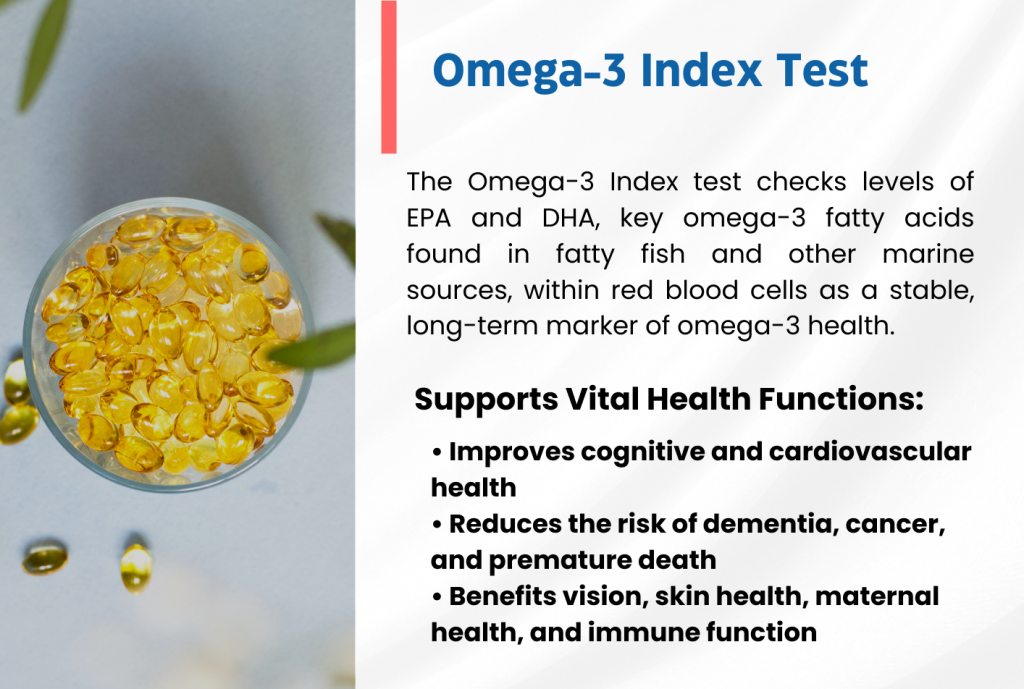
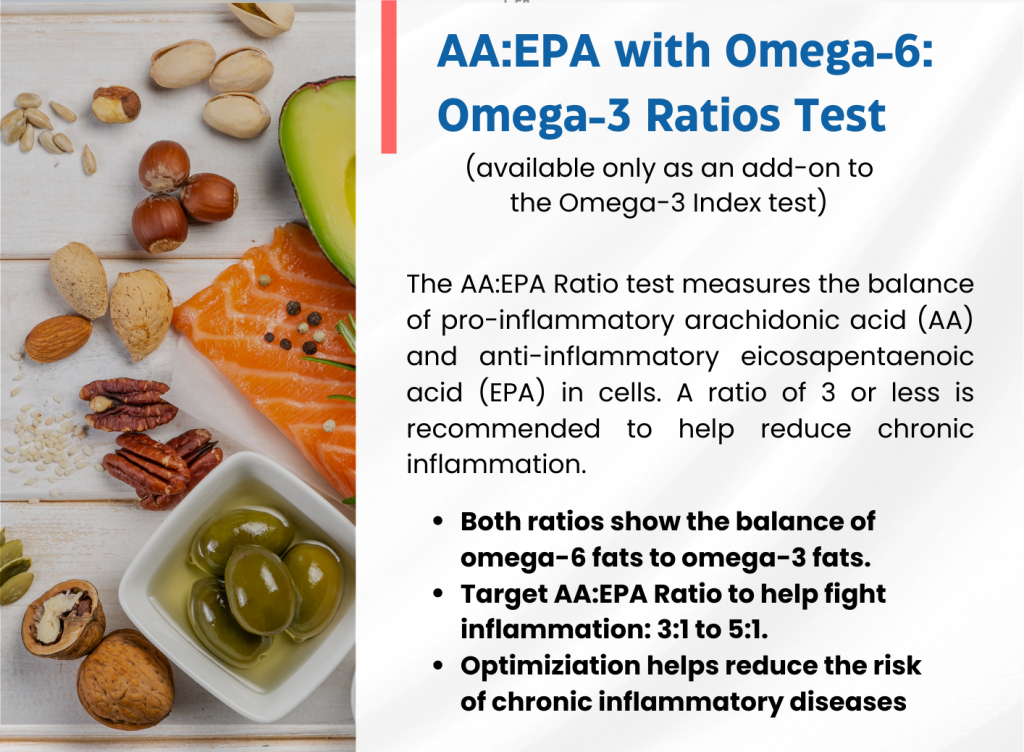
Magnesium PLUS Essential and Toxic Elements
It is important for essential elements to be within their normal or optimal range in order to fulfill their roles in maintaining health. When an essential element is out of range, it can lead to disease or sub-optimal functioning. Some essential elements, such as selenium, copper and zinc, can become toxic when they are too high.
Learn More About the Importance of Measuring these Elements
Magnesium
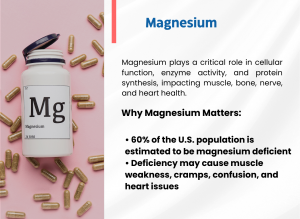 Magnesium is needed for hundreds of enzymatic reactions in the body and plays a significant role in cellular metabolism and protein synthesis. Deficiency can lead to problems with muscle, bone, nerve, and heart health with symptoms including muscle weakness and cramping, confusion, seizures, and cardiac arrhythmias.
Magnesium is needed for hundreds of enzymatic reactions in the body and plays a significant role in cellular metabolism and protein synthesis. Deficiency can lead to problems with muscle, bone, nerve, and heart health with symptoms including muscle weakness and cramping, confusion, seizures, and cardiac arrhythmias.
Up to 60% of the US population is estimated to be deficient in magnesium. Deficient magnesium levels can be due to insufficient magnesium in the diet, as well as problems with kidney function, alcoholism, and the use of diuretics and proton pump inhibitors.
The dried blood spot magnesium test measures the amount of magnesium within the red blood cells (RBC), and is a better indicator of magnesium status than the serum magnesium test. The reference range for magnesium (range of the average population the lab serves, does not necessarily indicate optimal range for health) is 29 – 51 mg/L.
Learn more about the importance of magnesium and research involving magnesium.
Learn More About Research Involving Magnesium
The following are included in the Full Elements Panel along with magnesium:
Copper
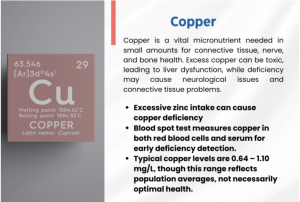 Copper is an essential micronutrient, important for normal development of connective tissues, nerve sheath, and bone; it is needed in very small quantities, but when found in greater concentrations than necessary, will become toxic and can lead to liver dysfunction. Symptoms of copper deficiency can include neurological dysfunction and connective tissue abnormalities.
Copper is an essential micronutrient, important for normal development of connective tissues, nerve sheath, and bone; it is needed in very small quantities, but when found in greater concentrations than necessary, will become toxic and can lead to liver dysfunction. Symptoms of copper deficiency can include neurological dysfunction and connective tissue abnormalities.
Too much zinc in the diet can lead to a copper deficiency, so it is important to also look at the zinc to copper ratio (Zn:Cu) to get a better picture of copper status.
The dried blood spot test for copper measures the amount of copper within the red blood cells as well as within the serum, and for this reason, can be more accurate and detect deficiencies earlier than a typical copper test of the serum alone. The reference range for copper (range of the average population the lab serves, does not necessarily indicate optimal range for health) is 0.64 – 1.10 mg/L.
Learn More About Research Involving Copper
Selenium
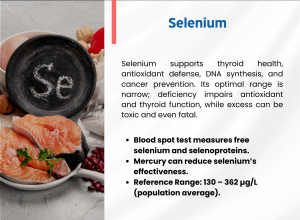 Selenium plays an important role in thyroid health, free radical scavenging, DNA synthesis, and cancer prevention. The optimal therapeutic range for selenium is narrow. Excess selenium can be toxic. A severe deficiency of selenium may lead to impairment of anti-oxidant actions and thyroid functions, whereas an excess of selenium may lead to death.
Selenium plays an important role in thyroid health, free radical scavenging, DNA synthesis, and cancer prevention. The optimal therapeutic range for selenium is narrow. Excess selenium can be toxic. A severe deficiency of selenium may lead to impairment of anti-oxidant actions and thyroid functions, whereas an excess of selenium may lead to death.
The dried blood spot selenium test reflects the level of free selenium in the blood as well as selenoproteins. Heavy metals, especially mercury, may impair selenium’s function by binding to it and preventing its bioavailability. The dried blood spot test can be useful for determining if enough selenium is present to counteract that interference. The reference range for selenium (range of the average population the lab serves, does not necessarily indicate optimal range for health) is 130 – 362 ug/L.
Learn More About Research Involving Selenium
Zinc
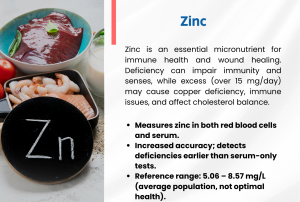 Zinc is an essential micronutrient which is important for immune health; it is needed in very small quantities, but when found in greater concentrations than necessary, can become toxic. Deficiency in zinc can lead to compromised immune function and wound healing, and can also affect taste and smell. Zinc in excess of 15 mg/day can lead to copper deficiency, impaired immune function, and can also have negative effects on the LDL/HDL cholesterol ratio.
Zinc is an essential micronutrient which is important for immune health; it is needed in very small quantities, but when found in greater concentrations than necessary, can become toxic. Deficiency in zinc can lead to compromised immune function and wound healing, and can also affect taste and smell. Zinc in excess of 15 mg/day can lead to copper deficiency, impaired immune function, and can also have negative effects on the LDL/HDL cholesterol ratio.
The dried blood spot test for zinc measures the amount of zinc within the red blood cells as well as within the serum, and for this reason, can be more accurate and detect deficiencies earlier than a typical zinc test of the serum alone. The reference range for zinc (range of the average population the lab serves, does not necessarily indicate optimal range for health) is 5.06 – 8.57 mg/L.
Learn More About Research Involving Zinc
Zinc/Copper Ratio
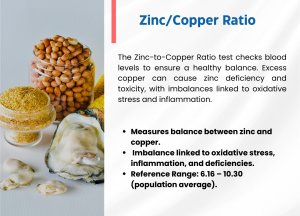 This test shows the ratio of the essential elements zinc to copper in the blood. These elements are considered antagonistic; excess of one can cause an imbalance of the other. For example, too much copper in relation to zinc can lead to toxicity and cause zinc deficiency, leading to dysfunction. An imbalance of these two essential elements has been correlated with oxidative stress and inflammation. The reference range for the zinc to copper ratio (range of the average population the lab serves, does not necessarily indicate optimal range for health) is 6.16 – 10.30.
This test shows the ratio of the essential elements zinc to copper in the blood. These elements are considered antagonistic; excess of one can cause an imbalance of the other. For example, too much copper in relation to zinc can lead to toxicity and cause zinc deficiency, leading to dysfunction. An imbalance of these two essential elements has been correlated with oxidative stress and inflammation. The reference range for the zinc to copper ratio (range of the average population the lab serves, does not necessarily indicate optimal range for health) is 6.16 – 10.30.
Learn More About the Zinc to Copper Ratio
Toxic elements have no known nutritional benefit and are known to interfere with proper functioning of proteins, lipids, and DNA within the cells. They can also interfere with essential elements by blocking their availability within the body. The three toxic elements tested with this panel, cadmium, lead and mercury, are in the top four of what the CDC considers the most toxic heavy metals, according to their priority list of hazardous substances.
Cadmium
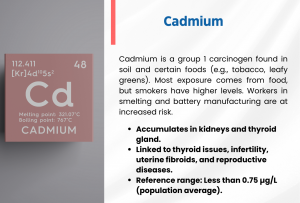 Cadmium, classified as a group 1 carcinogen, can be found in certain industrial environments and in soil. Certain plants and foods, such as tobacco, green leafy vegetables, potatoes and grains, peanuts, soybeans, sunflower seeds, and shellfish can contain high levels of cadmium. While the primary source of cadmium for most individuals is from food, smokers tend to have about twice the toxic burden of cadmium than non-smokers. Individuals who work in the smelting, battery manufacturing, colored glass manufacturing, and waste incinerating industries tend to have higher exposure to cadmium.
Cadmium, classified as a group 1 carcinogen, can be found in certain industrial environments and in soil. Certain plants and foods, such as tobacco, green leafy vegetables, potatoes and grains, peanuts, soybeans, sunflower seeds, and shellfish can contain high levels of cadmium. While the primary source of cadmium for most individuals is from food, smokers tend to have about twice the toxic burden of cadmium than non-smokers. Individuals who work in the smelting, battery manufacturing, colored glass manufacturing, and waste incinerating industries tend to have higher exposure to cadmium.
Cadmium accumulates in the kidneys and thyroid gland, and can contribute to thyroid issues, infertility, uterine fibroids, and other reproductive tract diseases.
The dried blood spot test for cadmium is a reflection of short-term cadmium exposure. The reference range for cadmium (range of the average population the lab serves, does not necessarily indicate optimal range for health) is less than 0.75 ug/L.
Learn More About Cadmium Levels
Mercury
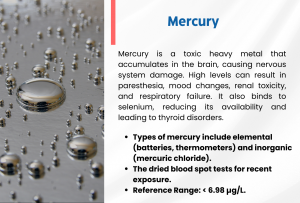 Mercury is a highly toxic heavy metal that can collect in the body’s tissues, especially the brain, where it can cause damage to the nervous system. High levels of mercury are associated with paresthesia, mood changes, sensory disturbances, renal toxicity, respiratory failure, and even death. Since mercury has a high affinity to selenium, it can also bind to it and reduce its biological availability, leading to diseases caused by selenium deficiency, such as thyroid disease.
Mercury is a highly toxic heavy metal that can collect in the body’s tissues, especially the brain, where it can cause damage to the nervous system. High levels of mercury are associated with paresthesia, mood changes, sensory disturbances, renal toxicity, respiratory failure, and even death. Since mercury has a high affinity to selenium, it can also bind to it and reduce its biological availability, leading to diseases caused by selenium deficiency, such as thyroid disease.
While some are exposed to mercury as an occupational hazard, most mercury exposure is due to consumption of fish and shellfish that contain methylmercury. The dried blood spot test for mercury is a good indicator of recent exposure to methylmercury. Other types of mercury include elemental mercury (found in batteries, thermometers, and dental amalgams), and inorganic mercury (found in mercuric chloride and skin-lightening creams). The reference range for mercury (range of the average population the lab serves, does not necessarily indicate optimal range for health) is less than 6.98 ug/L.
Learn More About Mercury Levels
Click to learn more about these tests and when they are important to consider.
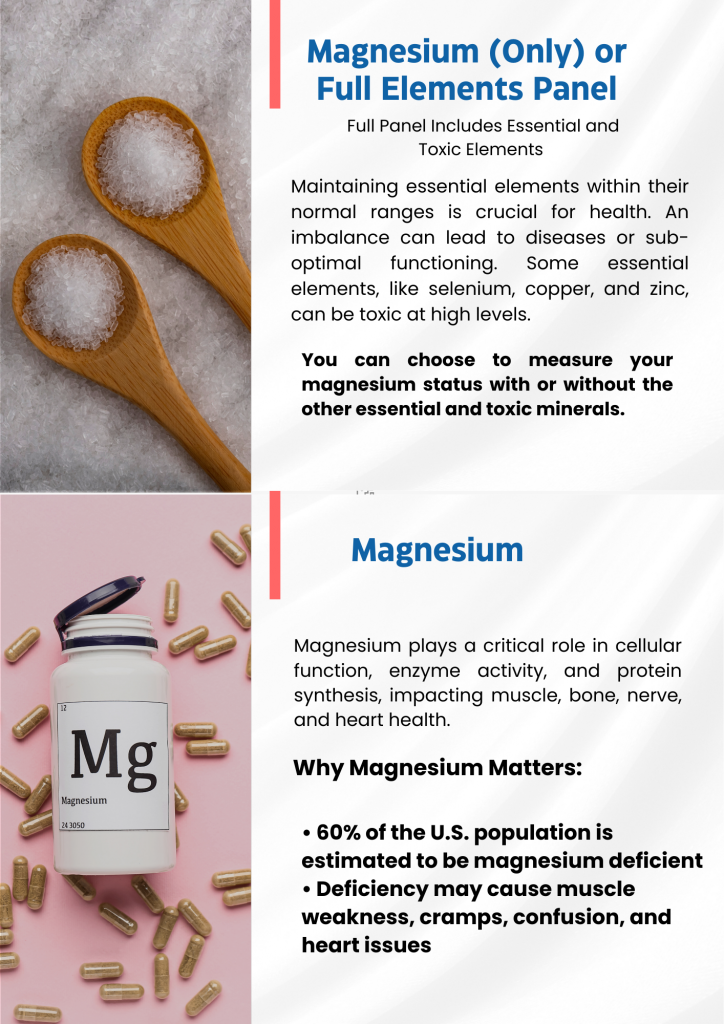
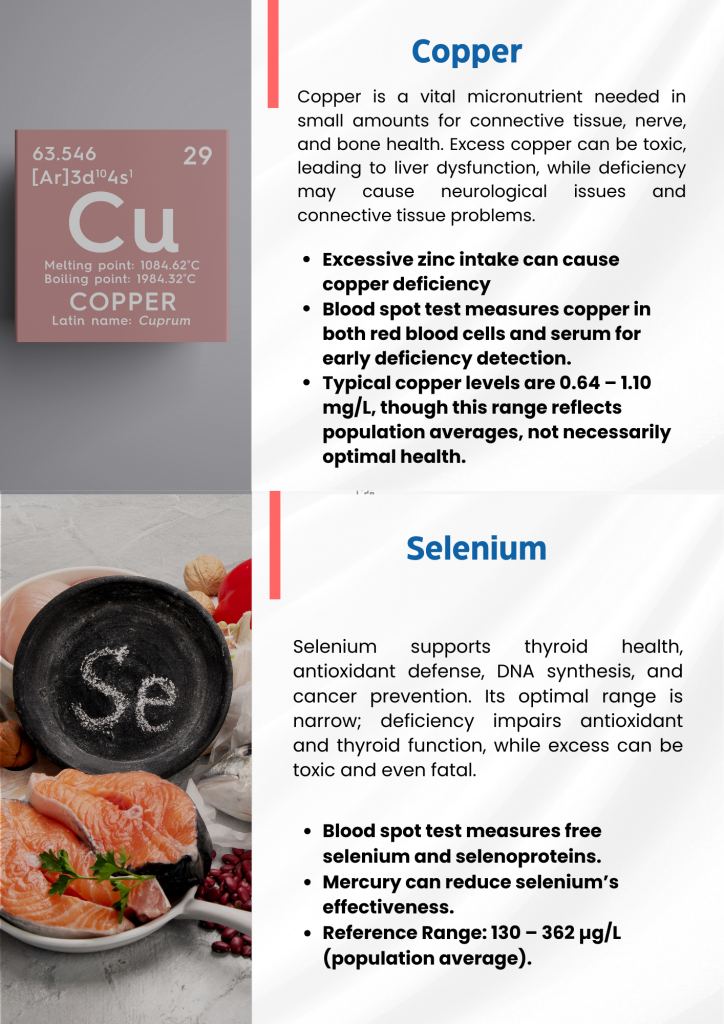
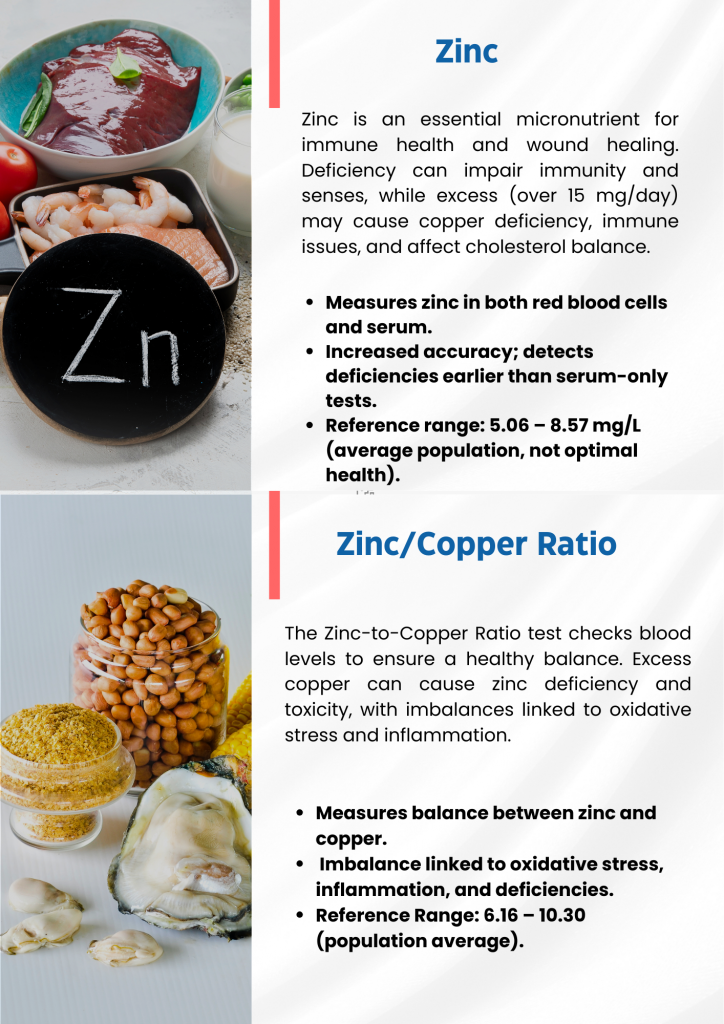
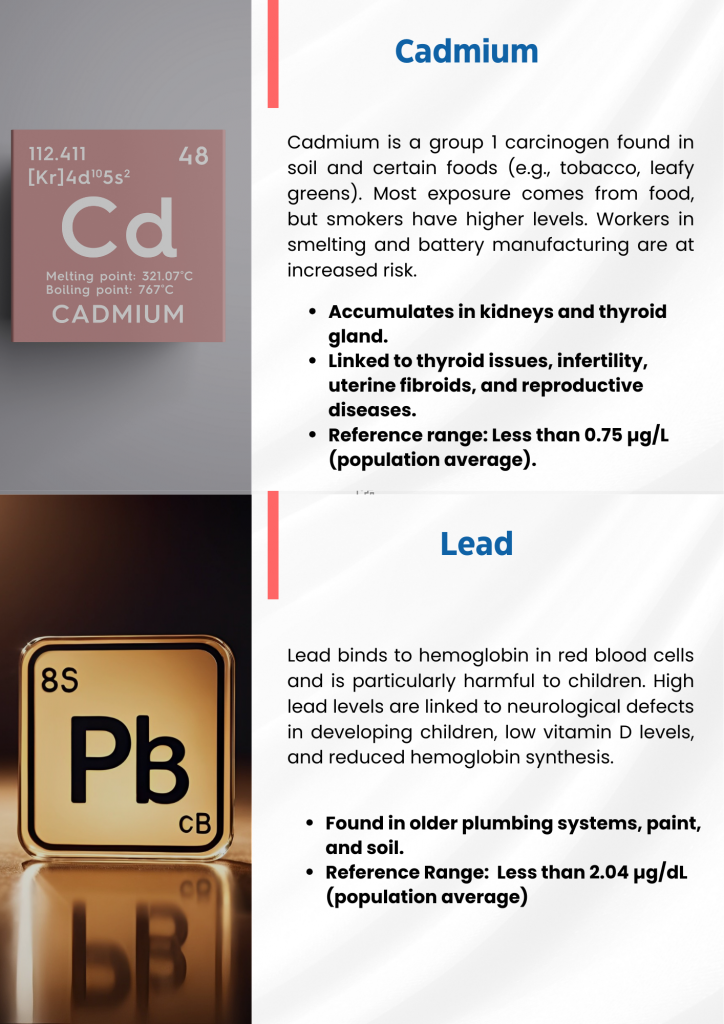
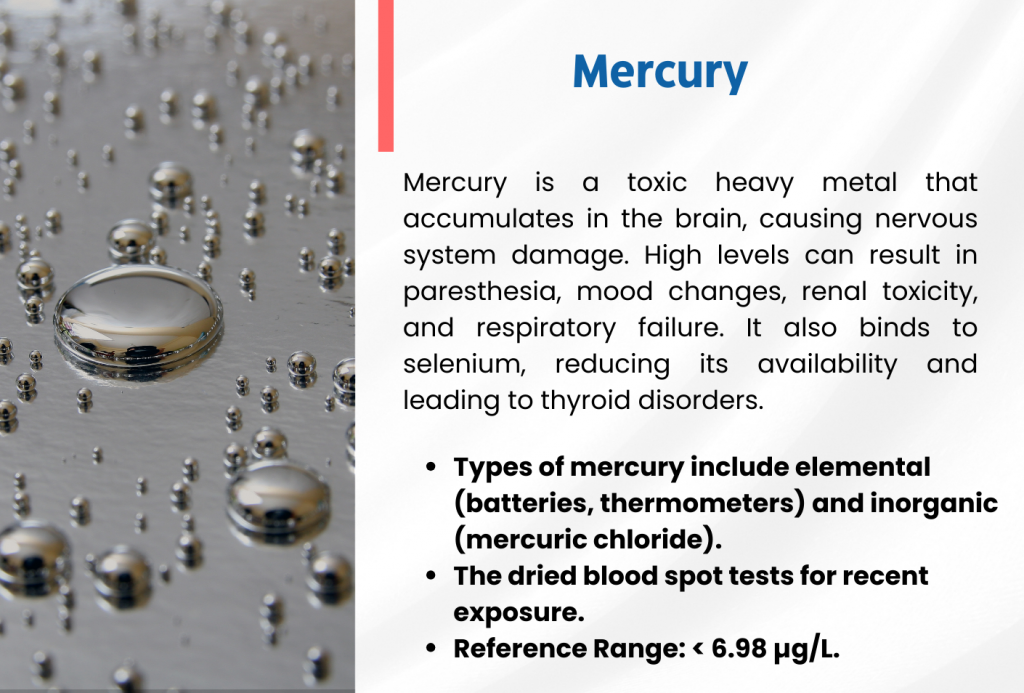
Measurements for Inflammation and Blood Sugar Regulation
High Sensitivity C-Reactive Protein (hs-CRP) Test
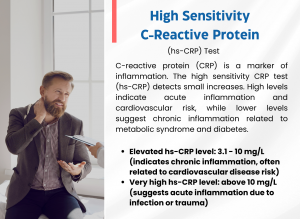 C-reactive protein (CRP) is a marker of the amount of inflammation in the body. This CRP test uses a high sensitivity assay, hs-CRP where “hs” means high sensitivity, to detect small elevations in CRP. High levels are seen in acute inflammation and have been correlated with high cardiovascular disease risk, while smaller elevations are indicative of chronic inflammation and chronic diseases, such as metabolic syndrome and diabetes.
C-reactive protein (CRP) is a marker of the amount of inflammation in the body. This CRP test uses a high sensitivity assay, hs-CRP where “hs” means high sensitivity, to detect small elevations in CRP. High levels are seen in acute inflammation and have been correlated with high cardiovascular disease risk, while smaller elevations are indicative of chronic inflammation and chronic diseases, such as metabolic syndrome and diabetes.
A normal hs-CRP level is below 3.0 mg/L. A level between 3.1-10 mg/L is considered elevated, usually seen in chronic inflammation such as that involved with cardiovascular disease risk. An hs-CRP level above 10 mg/ L is very high, more likely indicating an acute inflammatory event due to infection or trauma.
Learn more about the importance of measuring your CRP level along with your nutrient levels and review additional research involving CRP.
Click to learn more about this test and when is is important to consider.
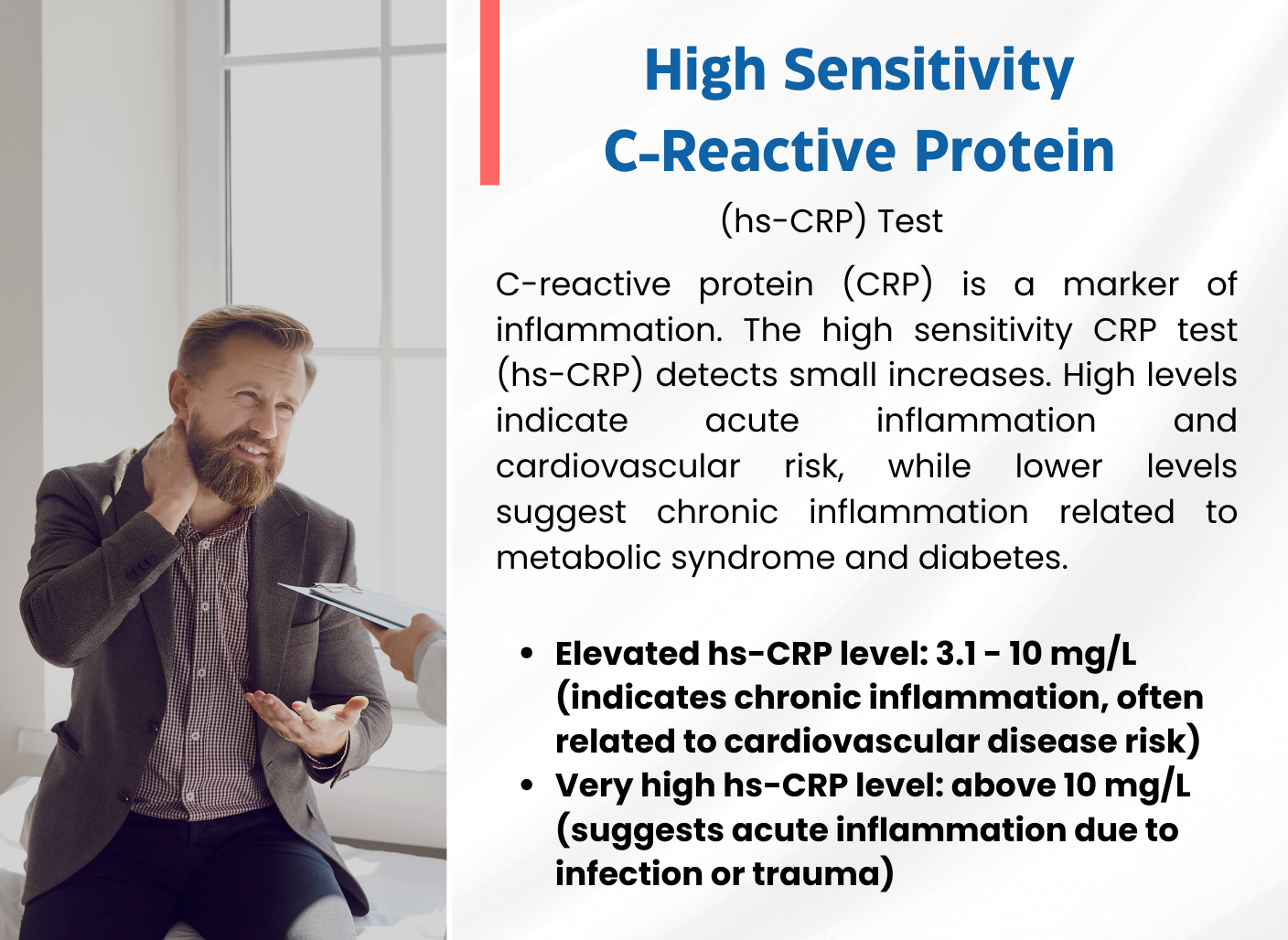
Hemoglobin A1c Test (HbA1c)
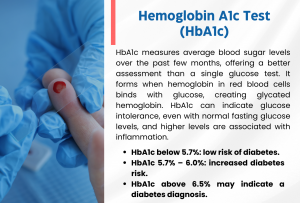 HbA1c is a measure of how healthy average blood sugar levels have been in the recent few months, and is a better representation of blood sugar health than a single glucose measurement, since glucose levels vary throughout the day. HbA1c is the compound formed in the blood when a hemoglobin molecule in a red blood cell binds with a glucose molecule in the blood; the resulting molecule is also known as glycated hemoglobin. It can be a good indicator of glucose intolerance even in the absence of abnormal fasting glucose levels, and higher levels of HbA1c are associated with inflammation.
HbA1c is a measure of how healthy average blood sugar levels have been in the recent few months, and is a better representation of blood sugar health than a single glucose measurement, since glucose levels vary throughout the day. HbA1c is the compound formed in the blood when a hemoglobin molecule in a red blood cell binds with a glucose molecule in the blood; the resulting molecule is also known as glycated hemoglobin. It can be a good indicator of glucose intolerance even in the absence of abnormal fasting glucose levels, and higher levels of HbA1c are associated with inflammation.
For individuals without diabetes, an HbA1c result of less than 5.7% is indicative of a low risk, while the range of 5.7% – 6.0% is indicative of an increased risk of developing diabetes. An HbA1c result of greater than 6.5% is usually related to a diagnosis of diabetes.
Some things can cause falsely low HbA1c levels, such as certain medications, high triglycerides, and liver disease. Deficiency of iron or vitamin B12 may cause falsely high HbA1c levels.
Learn more about the importance of measuring your HbA1c level and research involving HbA1c.
Click to learn more about this test and when is is important to consider.
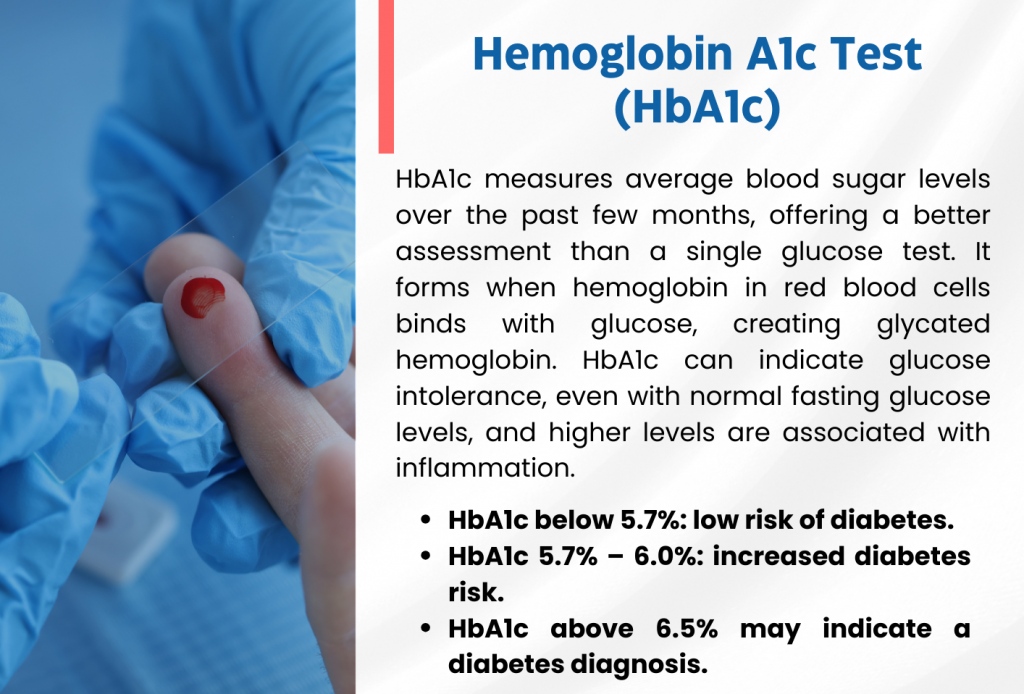
Type 1 Diabetes (T1D) Autoantibodies
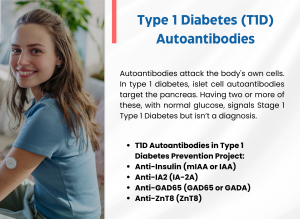 Autoantibodies are antibodies created by a person’s immune system that attack proteins in their own cells, as seen in many autoimmune diseases. The presence of the T1D islet cell autoantibodies indicates an autoimmune response against the cells of the pancreas, and is strongly associated with the development of T1D; the detection of these autoantibodies can be used as markers of the process that can cause type 1 diabetes. According to the American Diabetes Association, the presence of two or more of these autoantibodies in the blood, but with normal blood glucose levels, defines Stage 1 Type 1 Diabetes. **This does not mean that a person with two or more of these autoantibodies in fact has Type 1 Diabetes**
Autoantibodies are antibodies created by a person’s immune system that attack proteins in their own cells, as seen in many autoimmune diseases. The presence of the T1D islet cell autoantibodies indicates an autoimmune response against the cells of the pancreas, and is strongly associated with the development of T1D; the detection of these autoantibodies can be used as markers of the process that can cause type 1 diabetes. According to the American Diabetes Association, the presence of two or more of these autoantibodies in the blood, but with normal blood glucose levels, defines Stage 1 Type 1 Diabetes. **This does not mean that a person with two or more of these autoantibodies in fact has Type 1 Diabetes**
The presence of autoantibodies can change over time, and can be influenced by factors such as the status of the body’s immune system and levels of inflammation. Improved vitamin D and omega-3 status, as well as decreased inflammation, have been associated with lower levels of these autoantibodies and therefore lower risk of T1D development.
T1D autoantibodies tested for as part of the Type 1 Diabetes Prevention project include
- Anti-Insulin (also known as mIAA or IAA)
- Anti-IA2 (IA-2A)
- Anti-GAD65 (GAD65 or GADA)
- Anti-ZnT8 (ZnT8)
Learn More About the Type 1 Diabetes Prevention Project
Create your Custom Kit with your participation today!
Order & Enroll Now
Choose What to Measure While Participating as a Citizen Scientist!
Becoming a participant of GrassrootsHealth means that anyone is joining thousands of people in collaborating on nutrient research – we call it “citizen science.” Citizen science welcomes everyone’s participation in the discovery and sharing of scientific knowledge. As a citizen scientist, you’ll help everyone gain a better understanding of the role of nutrients in health and disease, and use the results to help inform public health officials to create change. Additionally, you can use your results to make informed decisions about nutrients that affect your health.
What Are Your Levels?
 Take steps to improve the status of each of these measurements to benefit your overall health. You can also track your own intakes, symptoms and results to see what works best for YOU.
Take steps to improve the status of each of these measurements to benefit your overall health. You can also track your own intakes, symptoms and results to see what works best for YOU.
Enroll and test your levels today, learn what steps to take to improve your status of vitamin D and other nutrients and blood markers, and take action! By enrolling in the GrassrootsHealth projects, you are not only contributing valuable information to everyone, you are also gaining knowledge about how you could improve your own health through measuring and tracking your nutrient status, and educating yourself on how to improve it.
